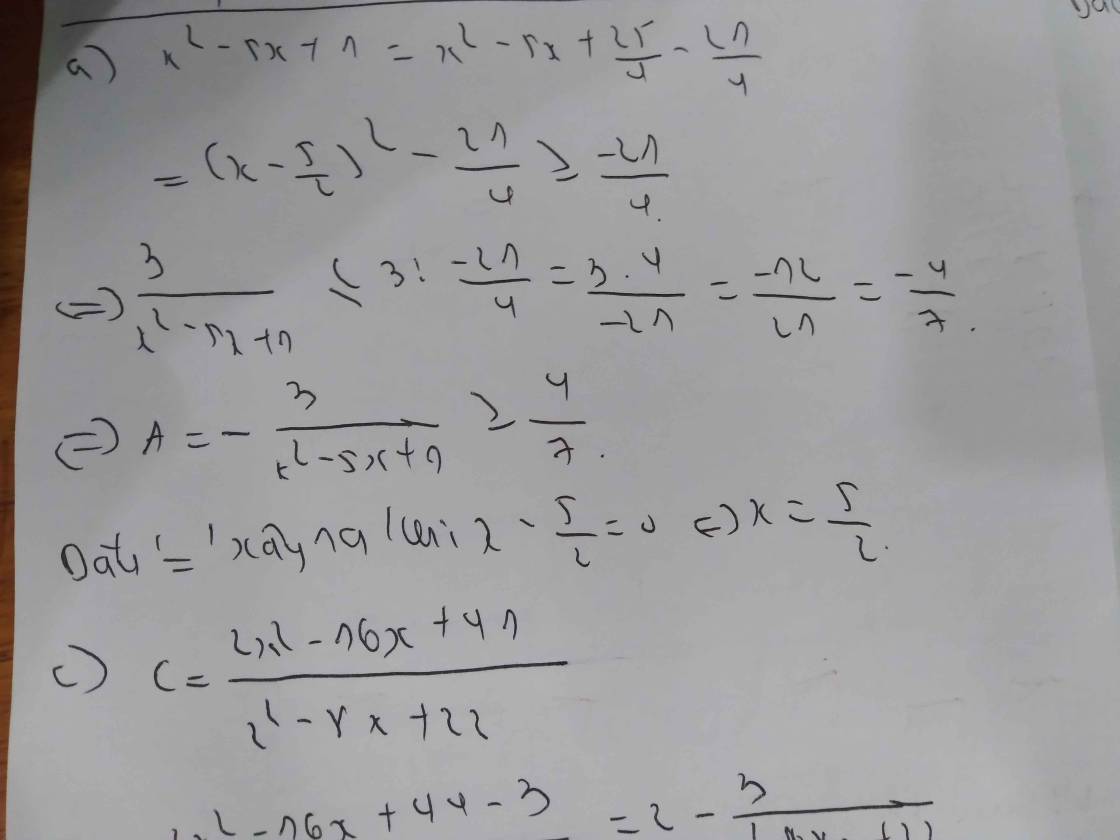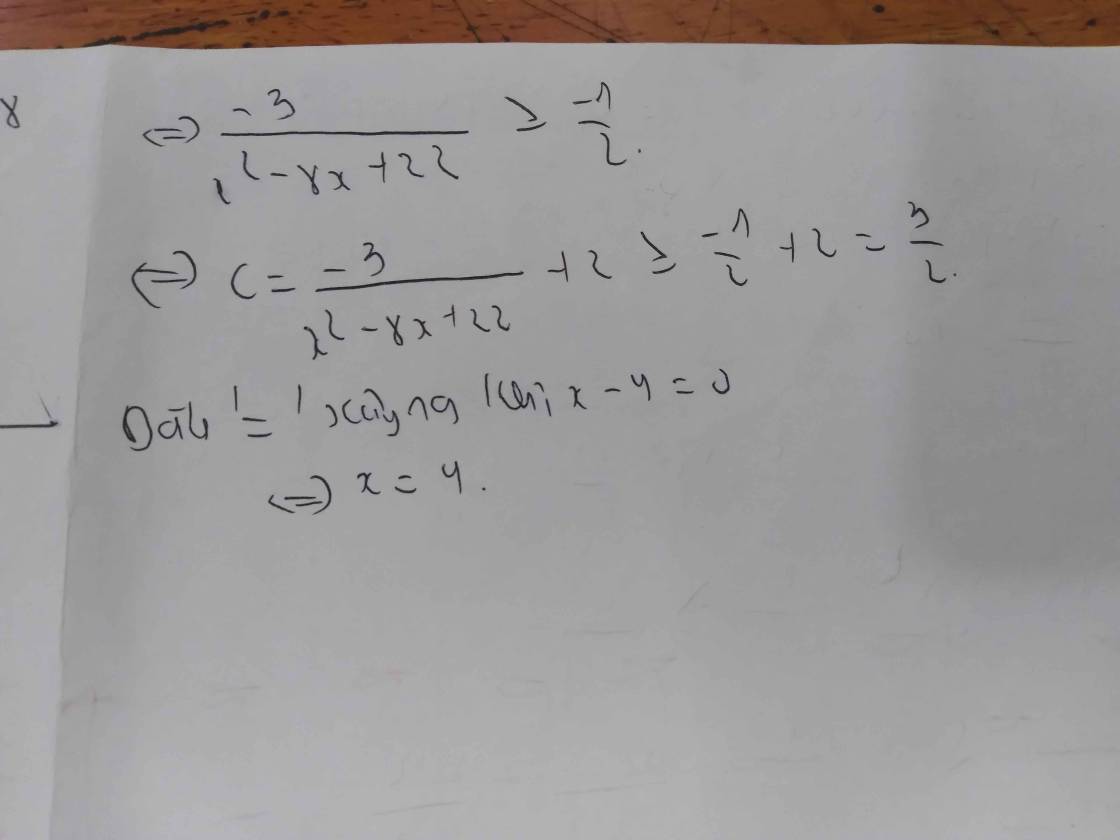
Hãy nhập câu hỏi của bạn vào đây, nếu là tài khoản VIP, bạn sẽ được ưu tiên trả lời.


\(A=2\left(x^2-4x+4\right)-7=2\left(x-2\right)^2-7\ge-7\)
Dấu \("="\Leftrightarrow x=2\)
\(B=\left(x^2+3x+\dfrac{9}{4}\right)-\dfrac{1}{4}=\left(x+\dfrac{3}{2}\right)^2-\dfrac{1}{4}\ge-\dfrac{1}{4}\)
Dấu \("="\Leftrightarrow x=-\dfrac{3}{2}\)
\(C=4\left(x^2-2x+1\right)-4=4\left(x-1\right)^2-4\ge-4\)
Dấu \("="\Leftrightarrow x=1\)
\(D=\dfrac{1}{-\left(x^2+2x+1\right)+6}=\dfrac{1}{-\left(x+1\right)^2+6}\ge\dfrac{1}{6}\)
Dấu \("="\Leftrightarrow x=-1\)
1.
$A=2x^2-8x+1=2(x^2-4x+4)-7=2(x-2)^2-7$
Vì $(x-2)^2\geq 0$ với mọi $x\in\mathbb{R}$
$\Rightarrow A\geq 2.0-7=-7$
Vậy $A_{\min}=-7$ khi $x-2=0\Leftrightarrow x=2$
2.
$B=x^2+3x+2=(x^2+3x+1,5^2)-0,25=(x+1,5)^2-0,25\geq 0-0,25=-0,25$
Vậy $B_{\min}=-0,25$ khi $x=-1,5$
3.
$C=4x^2-8x=(4x^2-8x+4)-4=(2x-2)^2-4\geq 0-4=-4$
Vậy $C_{\min}=-4$ khi $2x-2=0\Leftrightarrow x=1$
4. Để $D_{\min}$ thì $5-x^2-2x$ là số thực âm lớn nhất
Mà không tồn tại số thực âm lớn nhất nên không tồn tại $x$ để $D_{\min}$

A\(=2x^2-8x+1\)
=2x(x-4)+1≥1
Min A=1 ⇔x=4
B=\(x^2+3x+2\)
\(=\left(x^2+2.x.\dfrac{3}{2}+\dfrac{9}{4}\right)-\dfrac{1}{4}\)
\(=\left(x+\dfrac{3}{2}\right)^2-\dfrac{1}{4}\)≥\(-\dfrac{1}{4}\)
Min B=-1/4⇔x=-3/2

\(A=\dfrac{2x^2-8x+17}{x^2-2x+1}\left(x\ne1\right)\)
\(\Leftrightarrow A\left(x^2-2x+1\right)=2x^2-8x+17\)
\(\Leftrightarrow Ax^2-2Ax+A=2x^2-8x+17\)
\(\Leftrightarrow x^2\left(A-2\right)-2x\left(A-4\right)+A-17=0\left(1\right)\)
\(A-2=0\Leftrightarrow A=2\Leftrightarrow x=3,75\left(tm\right)\left(2\right)\)
\(A-2\ne0\Leftrightarrow A\ne2\Rightarrow\Delta'\ge0\Leftrightarrow\left(A-4\right)^2-\left(A-17\right)\left(A-2\right)\ge0\Leftrightarrow A\ge\dfrac{18}{11}\Rightarrow A_{min}=\dfrac{18}{11}\Leftrightarrow x=\dfrac{13}{2}\left(tm\right)\left(3\right)\)
\(\left(2\right)và\left(3\right)\Rightarrow A_{min}=\dfrac{18}{11}\Leftrightarrow x=\dfrac{13}{2}\)

a: Để A là số nguyên thì
x^3-2x^2+4 chia hết cho x-2
=>\(x-2\in\left\{1;-1;2;-2;4;-4\right\}\)
=>\(x\in\left\{3;1;4;0;6;-2\right\}\)
b: Để B là số nguyên thì
\(3x^3-x^2-6x^2+2x+9x-3+2⋮3x-1\)
=>\(3x-1\in\left\{1;-1;2;-2\right\}\)
=>\(x\in\left\{\dfrac{2}{3};0;1;-\dfrac{1}{3}\right\}\)

A = 2x^2 - 8 x + 10 + (y-3)^4
A = (2x^2 - 8x + 8) + (y-3)^4 + 2
A = 2.(x^2 - 4x + 4) + (y-3)^4 + 2
A = 2.(x^2-2)^2 + (y-3)^4 + 2 >= 2.
Dấu "=" xảy ra <=> x^2 - 2 = 0 và y - 3 = 0
<=> x = \(\pm\sqrt{2}\)và y = 3.
Vậy Min A = 2 <=> x = \(\pm\sqrt{2}\)và y = 3





